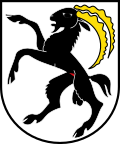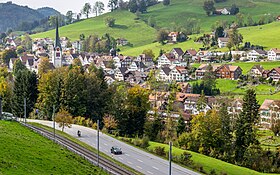Gais AR
| AR is the abbreviation for the canton of Appenzell Ausserrhoden in Switzerland and is used to avoid confusion with other entries of the name Gais . |
| Gais | |
|---|---|
| State : |
|
| Canton : |
|
| District : | former Mittelland district |
| BFS no. : | 3022 |
| Postal code : | 9056 |
| Coordinates : | 752 253 / 247694 |
| Height : | 933 m above sea level M. |
| Height range : | 780–1250 m above sea level M. |
| Area : | 21.21 km² |
| Residents: | 3091 (December 31, 2018) |
| Population density : | 146 inhabitants per km² |
| Website: | www.gais.ch |
|
Gais AR |
|
| Location of the municipality | |
Gais is a municipality in the central plateau of the canton of Appenzell Ausserrhoden in Switzerland .
geography
Gais is located between Teufen and Appenzell on the Appenzeller Bahnen route . Well-known excursion destination is the Gäbris at 1251 m above sea level. M. Gais is the end point of the Altstätten –Gais railway line . From Altstätten in the Rhine Valley , there is a direct road connection to Gais via the Stoss AR pass .
The neighboring communities are Trogen , Bühler , Schlatt-Haslen , Appenzell , Rüte , Eichberg and Altstätten.
history

population
| Population development | |
|---|---|
| year | Residents |
| 1667 | 1870 |
| 1850 | 2480 |
| 1900 | 2854 |
| 1950 | 2422 |
| 1980 | 2388 |
| 2000 | 2770 |
| 2010 | 3065 |
Personalities
- Bartholomäus Anhorn the Elder (1566–1642), Protestant Reformed pastor and historian in Graubünden and Appenzell, died in Gais
- Johannes Rechsteiner (1618–1665), mayor, mayor and delegate to the Diet
- Johannes Gruber (1640–1710), textile entrepreneur, member of the government and Landammann, born in Gais
- Lorenz Wetter (1654–1734), merchant, provincial cap master, provincial governor, governor and delegate of the Diet, born in Gais
- Jakob Gruber (1676–1750), farmer, member of the government, delegate of the Diet and Landammann, born in Gais
- Samuel Heim (1764–1860), entrepreneur, born in Gais
- Johann Konrad Zuberbühler (1787–1858), educator, councilor, mayor, district administrator and school inspector, born in Gais
- Johann Heinrich Heim (1802–1876), National Councilor and Government Councilor, born in Gais
- Johann Ulrich Grunholzer (1810–1880), community clerk, land clerk and politician, born in Gais
- Heinrich Jakob Heim (1828–1892), pastor, born in Gais
- Johannes Hofstetter-Meier (1838–1902), textile entrepreneur, cantonal councilor and councilor, born in Gais
- Albert von Keller (1844–1920), painter, born in Gais
- Louis Kürsteiner (1862–1922), civil engineer, born in Gais
- Eduard Schweingruber (1899–1975), Reformed theologian, until 1941 head of the Kurhaus «Kardia» in Gais
- Heinrich Altherr (1909–1993), dialect writer
- Hans Buschor (1933–2017), Catholic priest, 1972–1994 pastor in Gais
- Stefan Höhener (* 1980), former luge rider, born in Gais
- Albert Oehlen (* 1954), contemporary artist, lives in Gais
- Michael Albasini (* 1980), racing cyclist, lives in Gais
- Sandra Graf (* 1969), athlete, lives in Gais
Attractions
The village complex with the traditional wooden houses with curved gables and some representative stone buildings was mainly built after the fire of 1780. The houses around the village square and on Webergasse to Schwantleren in the northeast form the core of the village.
The Gais Reformed Church was built in 1781–1782 by Hans Ulrich Haltiner. Inside, there are Rococo - stucco from 1782 from the vicinity of Andrew and Peter Anton Mosbrugger.
The Haus zum Ochsen on the village square has a dome tower at the back. It was built in 1796 by Konrad Langenegger as the spa house of the old "Ochsen".
In the northern row of houses on the village square is the Eisenhut house , built in 1781, with a multiple curved gable.
The detached house , built in 1783 for the then governor Jakob Gruber, combines a late baroque sense of style with local architecture. It has a rococo portal and a double curved transverse gable which is high above the central axis. The upper floor is structured by colossal pilasters .
The battle chapel on the Stoss , east of Gais, was built in the 15th century to commemorate the Appenzell victory over an Austrian army in 1405 ( Battle of the Stoss ) and redesigned in 1955 by Johann Hugentobler.
photos
Others
Every two years, the final roll call of the exercise Blue Flag - Fo (u) r Peace Central Europe takes place in Gais . The last time this happened was in July 2019.
literature
- H. Werder: On the current dynamics of the cultural landscape of the Appenzeller Mittelland. 1984.
- K. Rechsteiner and A. Weishaupt: History of the community Gais. 2002.
- Eugen Steinmann: The art monuments of the canton of Appenzell Ausserrhoden, Volume 2: The district of Mittelland. (= The Art Monuments of Switzerland, Volume 97). Birkhäuser Verlag, Basel 1980, ISBN 3-7643-1174-6 . Pp. 288-359.
- Eugen Steinmann: Gais. (= Swiss Art Guide, No. 213). Ed. Society for Swiss Art History GSK. Bern 1977, ISBN 978-3-85782-213-1 .
Web links
- Official website of the municipality of Gais
- Thomas Fuchs: Gais. In: Historical Lexicon of Switzerland .
Individual evidence
- ↑ Permanent and non-permanent resident population by year, canton, district, municipality, population type and gender (permanent resident population). In: bfs. admin.ch . Federal Statistical Office (FSO), August 31, 2019, accessed on December 22, 2019 .
- ↑ Thomas Fuchs: Gais. In: Historical Lexicon of Switzerland .






